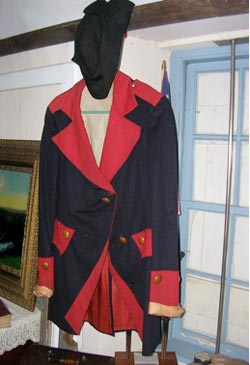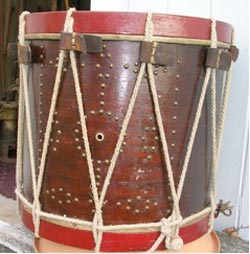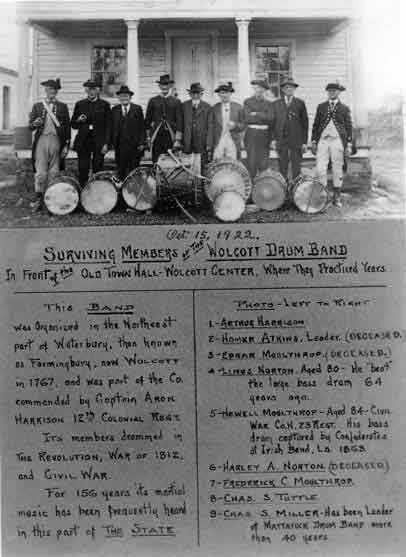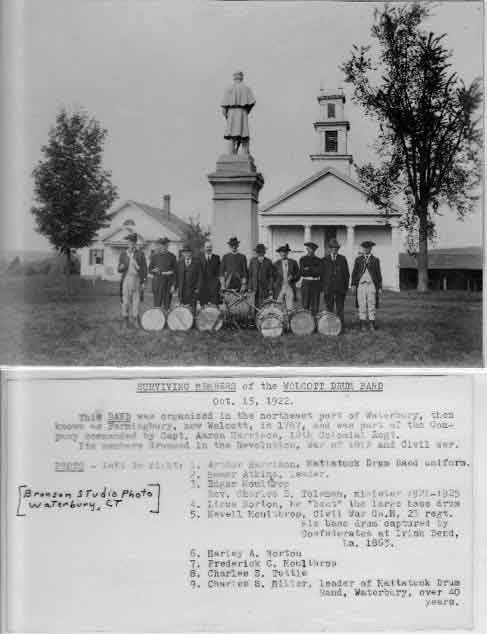|
|
||||||||||||
 |
 |
|
Wolcott Historical Society News - June 2009 By Florence Goodman In this edition, I will share the history of the oldest drum band in the Waterbury area, the Mattatuck Drum Band, because its origins are meshed with our early history. The Drum Band has had various names throughout its history. It originated as the Training Band, followed by the 10th Regiment Band, the Farmingbury Band, the Wolcott Drum Band, and since 1881, the Mattatuck Drum Band. Early settlers of the town were peace-loving people, but they realized it was important to be prepared to protect themselves and their property in times of need. By law, all male persons from the ages of 16 to 60 were subject to military duty and required to participate in Training Days, which took place six times a year. The Farmingbury men were attached to the Waterbury companies until the formation of their own militia. In 1767, the newly formed Farmingbury Train Band, which was part of the towns of Waterbury and Farmington, was founded under the command of Captain Aaron Harrison, Lt. Heman Hall, and Ensign Josiah Rogers. Drummers and fifers were essential components of the First Militia Company and were skillful in martial music and became known throughout the region for their patriotic sound. A quote from the Waterbury Republican-American recounts a colorful description of WolcottŐs "Training Day" held in 1803. "It is with the pride and boast of all farmers that their oxen and steers excel in stature; and that their military company is the tallest and the best equipped and disciplined in regiment, and at annual Train-Day their Drum Band is famous and sought by all public occasions far and near. During those early years of the establishment of the Farmingbury Parish and their Militia, the settlers were feeling the unrest that "taxation without representation" was creating throughout the English Colonies. Town residents protested the tyranny of King George III around "Liberty Poles" that had been placed on their Town Greens. As late as 1841, a Liberty Pole was still found on our Green. In May 1774, Captain John Alcott was commissioned by Governor Trumbull as captain of the Thirteenth Company of the trainband of Farmingbury Parish. In 1775, the trainband Company in Farmingbury consisted of 41 men. When a National Army was established in 1775 under General George Washington, the Farmingbury Company was disbanded. Many Farmingbury men enlisted as drummers and fifers in this newly formed Army; records indicate that at least 100 Farmingbury men served in various areas of action from Montreal, Canada, to Yorktown, Virginia. Zaccheus Gillet enlisted in July 1775 as a drummer in Col. Huntington's regiment operating near Boston and reenlisted in 1776 serving in the New York area. Samuel Benham, drummer, enlisted on May 1, 177,5 and reenlisted in 1776 and 1777. Benoni Gillet, son of Zaccheus, served as a drummer in the Continental Army. Nathan Gillet, fifer, another son of Zaccheus, enlisted in 1776 and served under General Washington. Thomas Welton, 3rd., fifer, enlisted in 1779. These are just a few of the soldiers from Farmingbury that served in the Revolutionary War and some of who gave their lives for our independence. At the end of the war, two companies of Trainbands were organized and commanded by Captain Heman Hall and Captain Levi Gaylord. Again, the Drum Band, although a separate unit, became an important part of the two companies. On general training days, the men were outfitted in bright red coats with brass buttons, buff pants, and plumed hats. Their leader was Nathan Gillet, who was said to be one of the best Fife Majors in the Continental Army. Their music was in great demand at social activities and at General Trainings. In 1796, when the town was incorporated and took the name of Wolcott, the Drum Band changed its name to the Wolcott Drum Band. During the War of 1812, recruits were again needed to help fight the war, so a recruiting station was set up in the far southern section of Wolcott at Lewis Tavern and another in Waterbury at East Farms. The officers of these companies called upon the Wolcott drummers to "drum up" volunteers for this war effort and they did. In 1830, Samuel Wilcox became the leader of the Drum Band. He introduced a new, original style of drumming based on notation with a full set of rudiments and beats; this became known as the "Wilcox Style." The Drum Band became renowned for its fine music and appearance until 1845, but soon after that date, the State Militia died out and so did interest in drum bands. The Wolcott Drum Band was not the same; uniforms were lost and worn out, members died and others moved away. Those that were left turned out at parades, rallies, and fairs without uniforms and many instruments were missing. When the Civil War broke out, drummers were scarce, but greatly sought after and again, the Wolcott drummers rallied. Sherman Moulthrop enlisted as a drummer in 1861 and served in New Orleans. Elihu Moulthrop enlisted in 1862 and served with General Sherman in Georgia. Newell Moulthrop enlisted in 1862, served in Louisiana and had his bass drum captured by the Confederates at Irish Bend. Drum Major George F.Hotchkiss enlisted as Captain in 1862 and served in the Army of the Potomac. Many of his men were killed or captured at Chancellersville, Virginia, on May 3, 1863. Early in 1862, Col. H.C. Hart was in Southington recruiting drummers and fifers for the Regimental Drum Band. While staying at a local inn, he heard drums in the distance and was told that the Wolcott Drum Band was practicing six miles away in the center of town. He hired a team and hastened to Wolcott. There he hired Mr. Henry Chatfield as leader and instructor and Hezekiah and Leslie Todd as fifers. They were able to recruit other drummers and fifers needed for the 71st Regiment of New York. Later, the 71st Regiment was said to be one of the best Drum Corps in the Army. When the war ended, many of the fifers and drummers found residence elsewhere, thus the Drum Band numbers were few, but they kept the band going. In 1872, Charles S. Miller joined the Drum Band at the age of fourteen. As a youngster, he lived in Wolcott with his grandmother, Mrs. A. Frisbie Somers, and attended school at the old stone schoolhouse on Nichols Road. By 1876, there were only five members left. In the fall of 1877, Mr. Levi Atkins and his son, Homer, reorganized the Band by teaching about 16 new young men how to fife and drum. They bought new uniforms, which consisted of red shirts, three-cornered hats, blue pants and white belts. They also had assistance from Elihu Moulthrop as Drum Major, and the hills of Wolcott once again were filled with that wonderful sound. Later, Captain George F. Hotchkiss took over as Drum Major. After several years, many of the younger boys lost interest and the older men were tired, so in 1881, Charles Miller and several East End Waterbury boys bought the equipment from the old Band and moved it to Waterbury; they renamed it the Mattatuck Drum Band. They chose the name because Mattatuck was the Indian name for Waterbury. There were still some Wolcott men that belonged to the new band. They were Charles S. Tuttle, Arthur Harrison, Franklin Browne, Robert Wakelee, Frederick C. Moulthrop, Bement Wakelee, Edgar Upson, and Morris Tyler. Much of the information that I used for this article was taken from the History of the Mattatuck Drum Band written by Charles Miller. Miller, also known as "Uncle Charlie" moved to the East End of Waterbury and lived at the corner of East Main Street and Frost Road. He made many of the drums that were used by the drummers in the Band and he taught more boys to drum during this period than anyone in Connecticut. Charles S. Miller kept daily journals throughout his life from 1876 until his death in 1943. His journals continually made reference to teaching students how to drum and fife. A portrait bust of Mr. Miller was unveiled on February 15, 1942, on the occasion of the 175th anniversary of the Mattatuck Drum Corps and Band. It also marked the 50th anniversary of Mr. MillerŐs direction of the Band. It is obvious that the Mattatuck Drum Band holds a special place in the hearts and history of early Wolcott residents. This is just one more example of the wonderful legacy our forefathers have left for us to enjoy. (Information for this article was taken from the Wolcott, Connecticut 175th Anniversary booklet 1796-1971 by John Washburne, History of the Town of Wolcott, Connecticut from 1731 to 1874 by Samuel Orcutt, History of the Mattatuck Drum Band by Charles Miller, and WOLCOTT in the French and Indian Wars, The Revolutionary War and The War of the Rebellion.) Attention: Garden lovers!!!SAVE the date - July 11th - for our Garden Tour. It will be held from 1 to 4 PM and we will have at least five gardens for your perusal. As a special bonus, when you purchase a ticket (for $10.00), you will get one FREE antique appraisal from CT ANTIQUE APPRAISALS by Carl Hotkowski. Any additional items will be appraised for $5 each. Hope to see you at the Garden Tour in July.
Mattatuck (nee Wolcott) Drum Band uniform at the Wolcott Historical Society Museum.
Mattatuck (nee Wolcott) Drum Band drum at the Wolcott Historical Society Museum.
Mattatuck (nee Wolcott) Drum Band suvivors in 1922.
Mattatuck (nee Wolcott) Drum Band suvivors in 1922. To view past installments of the Wolcott Historical Society News, click here. |
|
|
[Home]
[News]
[Purpose]
[Calendar]
[Museum]
[Membership]
[History]
[Contacts]
[Links]
All material at Wolcott Historical Society Web sites Copyright © 2000-2010 Wolcott Historical Society |



